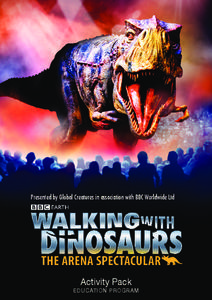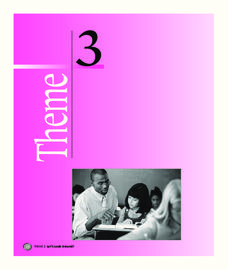Houghton Mifflin Harcourt
Nature Walk: English Language Development Lessons (Theme 2)
Walking in nature is the theme of a unit designed to support English language development lessons. Scholars look, write, speak, and move to explore topics such as camping, woodland animals, instruments,...
Berkshire Museum
Backyard Rocks
You don't have to travel far to learn about rocks, just step outside, pick up a stone, and begin investigating. After taking a class walk around the school grounds collecting rocks, young scientists practice their skills of observation...
BBC
Walking with Dinosaurs
Breath new life into your class's study of dinosaurs with this extensive collection of materials. Offering everything from a printable T-rex mask, word searches, and connect-the-dots activities to informational handouts, hands-on...
Rainforest Alliance
Knowing the Essential Elements of a Habitat
To gain insight into the many different types of habitats, individuals must first get to know their own. Here, scholars explore their school environment, draw a map, compare and contrast their surroundings to larger ones. They then...
US Department of Veterans Affairs
Sample Flexibility Plan for Beginners
Boost flexibility with a set of stretches designed for beginners. Pictures and descriptions guide readers through a variety of stretches while standing, sitting, and lying on the floor.
Houghton Mifflin Harcourt
Let’s Look Around!: Challenge Activities (Theme 3)
Let's Look Around! is the theme of a unit that offers a plethora of challenge activities. Enhance your scholars' learning experiences and reinforce concepts with activities such as writing a book about farm animals, an...
Shakespeare Globe Trust
Fact Sheet: London
Overcrowded streets, pickpockets, the Black Plague ... what's not to love about medieval London? With the informative handout, scholars explore some of the city's famous landmarks, such as St. Paul's Cathedral. They also discover where...
Cyberwise
Good Digital Citizenship Outdoors
It's easy to miss the beauty of nature when one's focus is on technology. Don't make that mistake with help from a two-page reference sheet that provides eight tips for staying present when exploring the world around you.
Penn Museum
Penn Museum: China Gallery
Invite your learners to take a closer look at the art and mathematical function of dome buildings as designed by the ancient Romans. In the next segment of this attractive activity set, your young historians will then learn about ancient...
Houghton Mifflin Harcourt
Around Town: Neighborhood and Community: English Language Development Lessons (Theme 3)
Here is a unit designed to support English language development. Scholars speak, move, and write to learn more about topics that focus on community and local concepts. The series of lessons aids to reinforce concepts...
Chandler Unified School District
Ben Franklin Aphorisms
Benjamin Franklin's famous aphorisms are a perfect time capsule of colonist values in the mid-18th century, as well as a clever reminder of the way life still works today. Middle and high schoolers select one aphorism to interpret...
Australian Broadcasting Corporation
Australian Broadcasting Corporation: Walking With Dinosaurs: Fact File: Ophthalmosaurus
Read information about the dolphin-shaped opthalmosaurus, and learn what fossil evidence tells us about this marine dinosaur's hunting, anatomy, and young. View a listing of quick facts about the opthalmosaurus' size and diet, and launch...
Other
Ex Zo Oberance: Chameleons
This resource presents an online index of walking animals. The article deals directly with the characteristics and behavior of the chameleon.
Museums Victoria
Melbourne Museum: Meet the Skeletons: Deinonychus Antirrhopus
Deinonychus antirrhopus was a small, carnivorous theropod dinosaur from the Cretaceous Period, first discovered in the United States. A study of its skeleton revealed that it was fast-moving, which went against previously held beliefs...
Museums Victoria
Melbourne Museum: Meet the Skeletons: Tsintaosaurus Spinorhinus
Tsintaosaurus spinorhinus, a type of hadrosaur, was a herbivorous dinosaur from the Late Cretaceous Period. Its fossilized remains have been found in China. Some information and pictures can be found here.
Museums Victoria
Melbourne Museum: Meet the Skeletons: Quetzalcoatlus Northropi
Quetzalcoatlus northropi was a carnivorous pterosaur larger than an African elephant. It lived during the Cretaceous Period. Some information and pictures can be found here.
Museums Victoria
Melbourne Museum: Meet the Skeletons: Pteranodon Sternbergi
Pteranodon sternbergi was a prehistoric flying reptile that lived during the Cretaceous Period. Some information and pictures can be found here.
Museums Victoria
Melbourne Museum: Meet the Skeletons: Protoceratops Andrewsi
Protoceratops andrewsi was an herbivorous dinosaur from the Late Cretaceous Period, related to the Triceratops. Some information and pictures can be found here.
Museums Victoria
Melbourne Museum: Meet the Skeletons: Varanus (Megalania) Priscus
Varanus priscus was a prehistoric lizard that lived in Australia in the Pleistocene Period. Some information and pictures can be found here.
Museums Victoria
Melbourne Museum: Meet the Skeletons: Mamenchisaurus Hochuanensis
Mamenchisaurus hochuanensis was an herbivorous Sauropod from the Late Jurassic Period, first discovered in China. Some information and pictures can be found here.
Museums Victoria
Melbourne Museum: Meet the Skeletons: Inostrancevia Alexandri
Inostrancevia alexandri was a prehistoric animal with mammal-like characteristics that lived in the Permian Period and before the dinosaurs. Some information and pictures can be found here.
Museums Victoria
Melbourne Museum: Meet the Skeletons: Hypsilophodon Foxii
Hypsilophodon foxii was an herbivorous Ornithopod from the Early Cretaceous Period. Its fossilized remains have been found in England. Some information and pictures can be found here.
Museums Victoria
Melbourne Museum: Meet the Skeletons: Hadrosaur
The Hadrosaur was a herbivorous Ornithopod dinosaur from the Late Cretaceous Period. Its fossilized remains have been found in Canada and elsewhere. Some information and pictures can be found here.
Museums Victoria
Melbourne Museum: Meet the Skeletons: Genyornis Newtoni
Genyornis newtoni was a gigantic, non-flying bird that lived in Australia during the Pleistocene Period. It is sometimes referred to as a 'thunder bird' due to its large size. Some information and pictures can be found here.
Other popular searches
- Story Map Picture Walk
- Reading Picture Walk
- Picture Walk Esl
- Lesson Picture Walk
- Picture Walk Dna
- Picture Walk Segregation
- Picture Walk Worksheet
- Picture Walk Chemistry
- Picture Walk Integration
- Picture Walks in Books
- Picture Walk Lesson Plans












